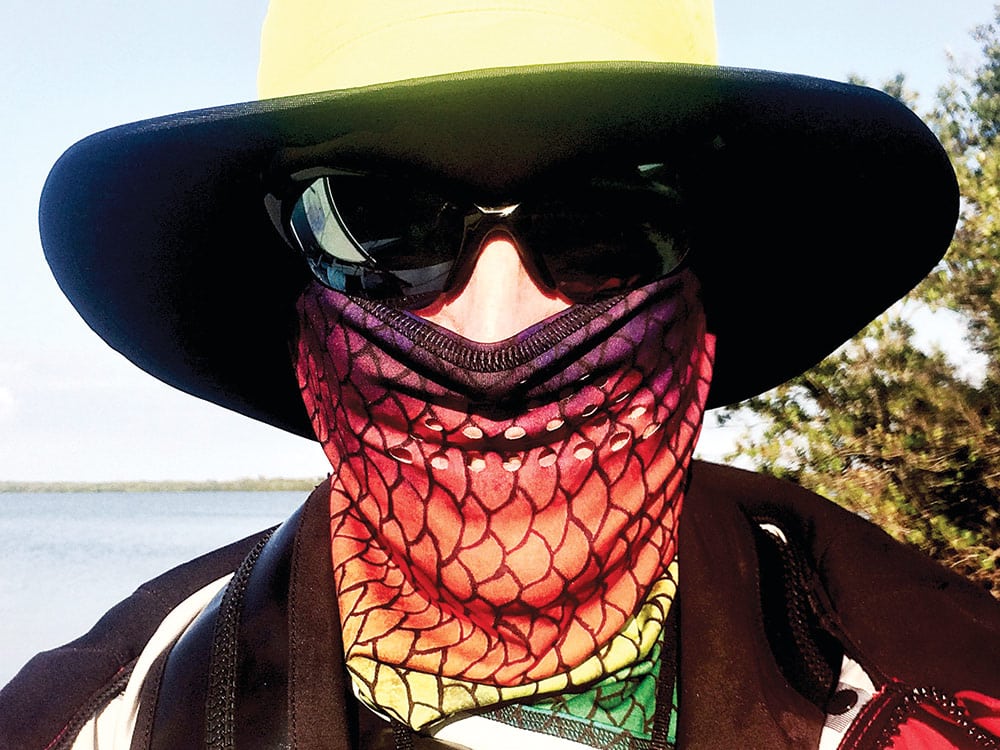
Sailing down the west coast of Florida always sounded good to me, especially in March, when my alternatives are either frostbiting, driving long distances in search of sailable ice or moping in front of a fireplace. The Everglades Challenge offers an ideal winter escape in the format of an expedition-style small-craft adventure race for kayaks, canoes and sailboats. The regatta — if you want to call it that — typically starts on the first Saturday of March. Contested for the first time in 2001, it has now taken place 18 times, organized by a group calling itself the WaterTribe. The race’s website is a convoluted portal to various databases, racetracks, routes, maps, results tables and rosters, offering a truthful representation of the mostly lovable, amateurish character in which this organization invites like-minded enthusiasts to go adventuring.
The Everglades Challenge has proliferated to include racecourses in North Carolina and Florida, and even one around (as in through) the state of Florida. The $1,500 registration fee for the longest track includes a free T-shirt but little else beyond the course suggestion and an ego-stroking “attaboy.”
This tribe of watermen and -women was founded and is led by Steve Isaac, who fittingly goes by “Chief.” He’s been criticized for his authoritarian style, haphazard organization and questionable financial motives, but be that as it may, after keeping an eye on this event for many years, this spring, I finally committed to entering. The challenge of making it to Key Largo on one’s own bottom, as well as the camaraderie among the participants, is the true attraction.
All entries of WaterTribe events are grouped into one of six classes (number of hulls, number of crew, etc.). In past years, hall-of-famer and multihull Olympian Randy Smyth has covered the 300-mile course from Fort de Soto to Key Largo in less than two days, dashing south through the night alone on an experimental boat called Sizzors, a shallow-draft shape-shifting carbon-fiber trimaran you have to see to believe. This year, he has a new version, powered by a semisolid wing sail.
Other crewed beach cats and trimarans also regularly cover the full distance in 48 hours or less. Crewed monohulls, custom and off the shelf, often do well too, finishing the course in less than three days. A few of the monohulls have sufficient open-water-sailing capability, and practical handling when in shallow areas or becalmed. They also offer reasonable protection for off-watch crew and comfort at anchor. Hobie Tandem Islander rotomolded trimarans, sailed hard and through the nights, have also made it to Key Largo in less than three days.
Most participants bring solo kayaks, with and without sail and outrigger support. Covering this 300-mile course in a kayak within the eight-day time limit, however, is a serious endeavor, and finishers are the extremely fit and capable sort.
Pelican Resort in Key Largo is the final destination, and the window to finish officially closes eight days after the start. Everyone is required to stop at three checkpoints along the way: From north to south, they’re Cape Haze Marina, Chokoloskee and Flamingo. Besides encouraging courses inside the coastline’s barrier islands, the checkpoints are more convenient for kayakers than for sailboats. Conversely, rough-water stretches across Tampa Bay, Pine Island Sound and, potentially, the Gulf, favor robust sailing vessels. When using a short portage in Flamingo, kayaks can even cross White Water Bay, thus approaching Flamingo from the inside. Paddlers favor the 99-mile inside track from Everglades City to Flamingo known as the Wilderness Waterway. Going outside, however, is much more direct, and faster for sailors.
My vessel of choice for this challenge is Kairos, a capable Angus RowCruiser. The boat, available as a kit or set of plans, is ideal for extended bouts of water camping and mixed cruising/racing occasions. This race will also serve as practice for my 2018 Race to Alaska, a similar race that starts in Port Townsend, Washington, and finishes in Ketchikan, Alaska. I retired from the 2017 R2AK when a mast support bracket (of my own engineering) in my new and untested boat came loose after 150 miles. I’ve since sorted the issue out for the race, and I’m confident the issue has been fixed. I also switched from a furling main, scavenged from a Hobie Islander, back to Angus’ original design with a fully battened main patterned after the O’pen Bic.
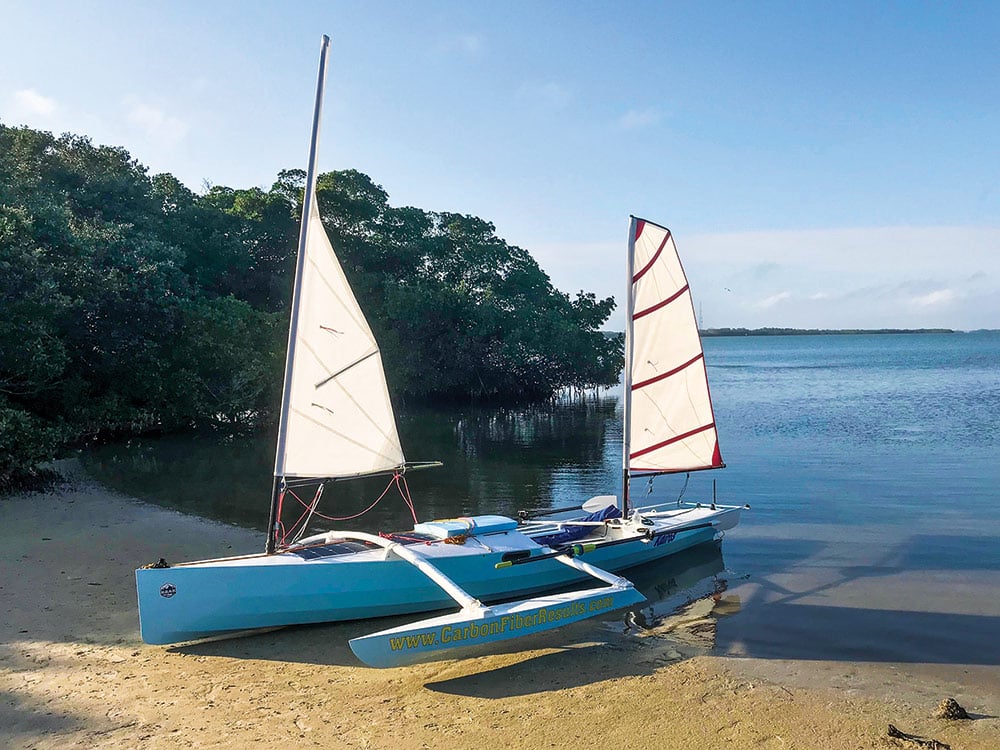
Friday, the day before the start, is a busy day. All 100 or so competitors are required to complete a check-in process, which starts with completing liability waivers and a PFD inspection before moving to boat and equipment checks. The inspections are thorough. I have to demonstrate that my emergency knife, tied to my PFD, can be opened using one hand. Check. My Garmin inReach (a satellite-based emergency communicator and locator device) must be tied to my PFD. Wearing the device around my neck, over my drysuit and under my PFD, is not acceptable. Oh well. The knife, too, must be lashed to my PFD, not to my drysuit pocket.
There’s an organizational debate about whether my inReach unit even qualifies as the required personal locator beacon. Opinions among the WaterTribe authorities differ, but they eventually accept the inReach unit. My boat also needs to be equipped with a separate Spot device since that is the only type of satellite beacon the official event website is able to track. I have one. It’s activated, it’s synced and it’s tracking, so we are good.
“Who built it?”
“I did.”
“Are these your regular sails?”
“Yes.”
“How do you reef them?”
“Easy,” I explain. “I engage the autopilot (‘Wait. What? Your boat has an autopilot?’), pull out the mast, remove the sleeved sail and put the bare pole back into the mast step. I roll and stow the sail, get out a smaller sail, put it on the mast, and off we go.”
“No, I mean how do you reef the sails?” one of the inspectors persists.
“I just told you.”
“But that’s not a proper reefing system.”
The back-and-forth continues until he asks me if I can modify my boat quickly.
“No, I don’t think I could or would want to,” I tell him. “And by the way, I have already crossed the Strait of Juan de Fuca with this boat, in a gale, and Colin Angus has completed the entire R2AK in the same. You can look it up. It’s not an unproven boat or rigging system.”
He doesn’t budge. Nor do I. “OK then,” he informs me, “you’re disqualified.”
There’s no question I will sail the course regardless of my status. I’m here for the sailing, to enjoy my time in the warm Florida waters and nature, to enjoy seamanship challenges and embrace the camaraderie of my fellow sailors. Screw the racing; that’s the least of it at this stage of my sailing life. I load the last supplies into the boat and double-check everything. I’m done by 7 p.m., and I head to town for one last full meal.
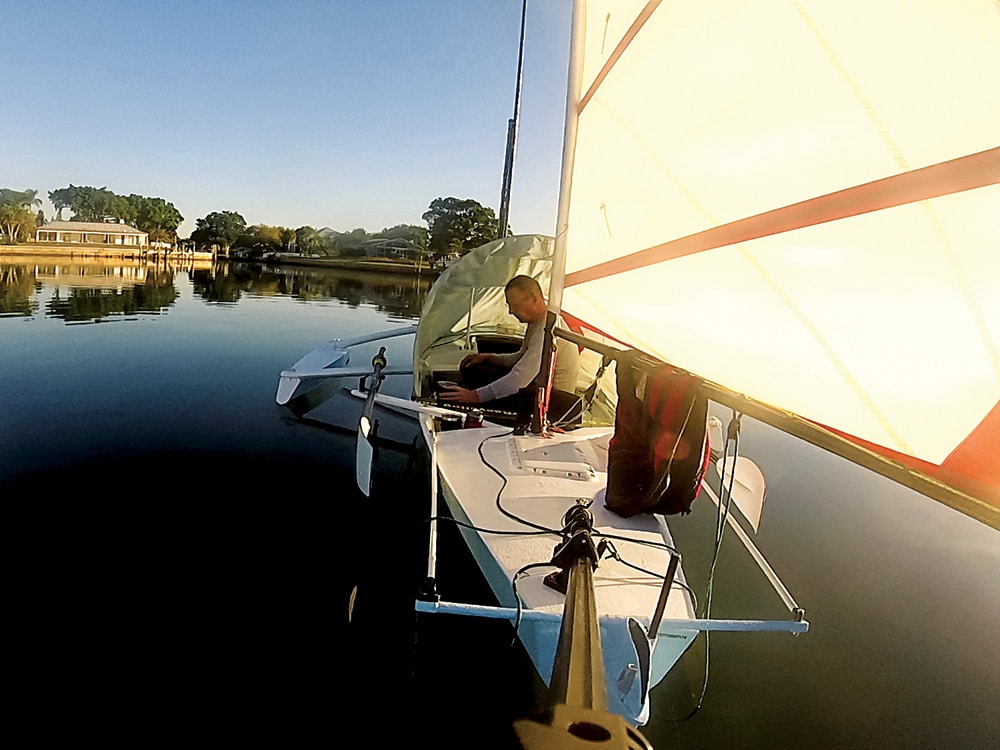
With a two-hour delay due to strong winds, the race finally gets underway from Fort de Soto on Saturday morning, March 3. Over the next two days we’ll move swiftly down the coast, pushed by a strong northwesterly tailwind and reeling in most of the 150 miles to Marco Island. Aside from cutting out sleep, I don’t think there’s a way I can progress much faster. I expect lighter winds ahead, and before long, the relentless pace slows to a crawl, giving me a chance to cruise and enjoy these very unique waters.
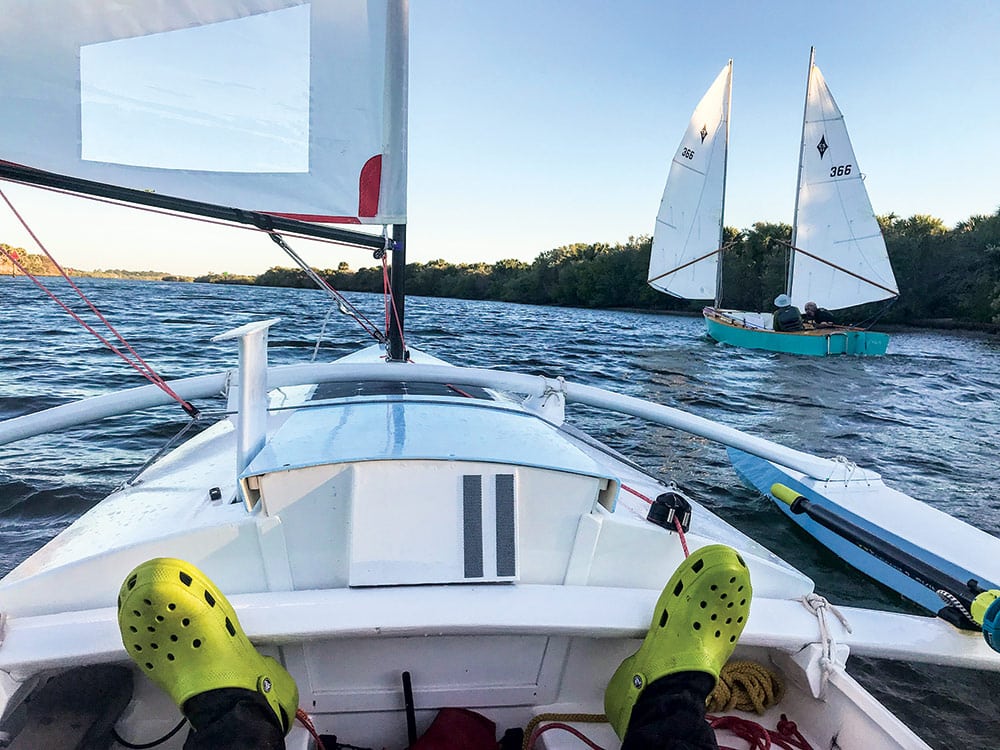
I reach the second checkpoint in Chokoloskee after dark on the third day. I anchor close to the shoreline and experience a surprisingly noisy night. Nearby Everglades City and its airport are a major hub of construction. Hurricane repairs, I guess.
Light winds persist the following morning, directly on the nose, so my progress is slow, and the annoyances of waterfront civilization are grating on me: high-rise condos, jet skis, powerboats, noise, traffic. I can’t wait to get away from it.
The forecast for the following day has the wind freshening and shifting to the west, which gives me reason to dive into Lostmans River at 2 p.m. I anchor in a shallow lagoon, away from the deeper channel. I’m well protected between islands, but not so close that the no-see-ums are getting to me. Now I’m really inside the Everglades National Park, in a part called the Ten Thousand Islands, a vast and remote labyrinth of water and mangroves bursting with aquatic wildlife of all kinds, and a nursery for many species.
I’m inside the Everglades National Park, in a part called the Ten Thousand Islands, a vast and remote labyrinth of water and mangroves bursting with aquatic wildlife.
I spend the late afternoon tending to the boat’s needs, reading and recovering from the previous day’s boat traffic. My choice of navigation equipment is starting to break down, so that’s a major. I’m running Navionics on a dedicated iPhone, with another one available as backup. All devices are in waterproof housings, and I have all the necessary power requirements to run the navigational software: a solar panel and charged backup batteries. What I had not anticipated was the two charging cables quickly corroding. Perhaps iPhone technology is not meant for the salty high seas after all. I have paper charts, and this part of the coast is not difficult to navigate, but now I better conserve whatever charges I have remaining. I turn all phones off, and am left with satellite tracker and VHF radio. There is no cellphone coverage here anyway, so I drift into a state of disconnected bliss.
As the evening light fades, life in this unspoiled bay is transformative. I hear the mangroves come alive. There’s splashing in the channel, followed by four deep breaths, which means dolphins are rounding up mullets. My mizzen sail, now pointing forward, is letting me know that the outgoing tide has placed me gently onto the sandy ground. I might not have noticed it otherwise, such is the stability of my little trimaran. This night shall be the only one of the entire trip during which I’m not hearing a combustion engine.
By morning, the wind shifts southwest and strengthens. I venture out into the Gulf, tacking occasionally. The waves of the shallow coast slow my progress. By afternoon, I’m well past Little Shark River, the last protected anchorage before I have to commit to rounding Cape Sable, from which I can head for the next checkpoint in Flamingo. Dark thunderclouds billow to the west and move closer. I swear I can see waterspouts. Time to reef my mainsail. The gust bands miss me by a mile or so, and soon I’m back to the full main. It’s getting late. If I continue beating around Cape Sable, I’ll be approaching Flamingo in the dark. With paper charts only, and no need to rush, I backtrack into the anchorage inside Little Shark River. This concludes another mellow cruising day, followed by another afternoon of solitude, reading and observing. As dusk falls, Venus is visible first. The night sky, away from light pollution, is truly magnificent.
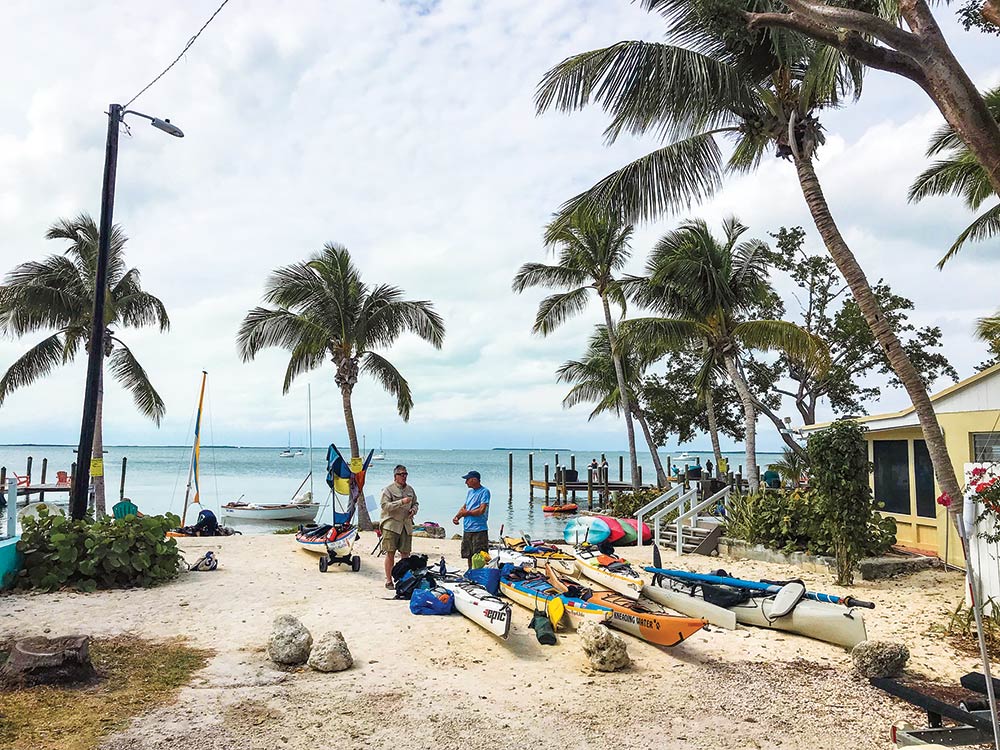
Thursday morning, I make way for Flamingo again. A steady 15-knot westerly kicks up brown chop, which makes for good sailing conditions and a decisively wet passage around Cape Sable. I arrive at the Flamingo checkpoint by 2 p.m., where I’m informed by race officials that the sole stand-up paddleboard participant had died a few days earlier when he fell off his board and drowned. I also learn that Smyth capsized during the first night and was rescued by the Coast Guard.
A friend is waiting for me in Flamingo. She’s followed my tracker and greets me with my car and boat trailer. Since I’m not an official entrant, I retrieve my backup charging cables from the car, thus regaining full digital navigation but technically violating the no-outside-support rule. I could promptly head out again and cross Florida Bay in the favorable west wind, but I’m in cruising mode now and opt for deeper exploration of Flamingo and a hot shower at the campsite. It’s cool and windy, so the infamous Flamingo mosquitoes are kept at bay.
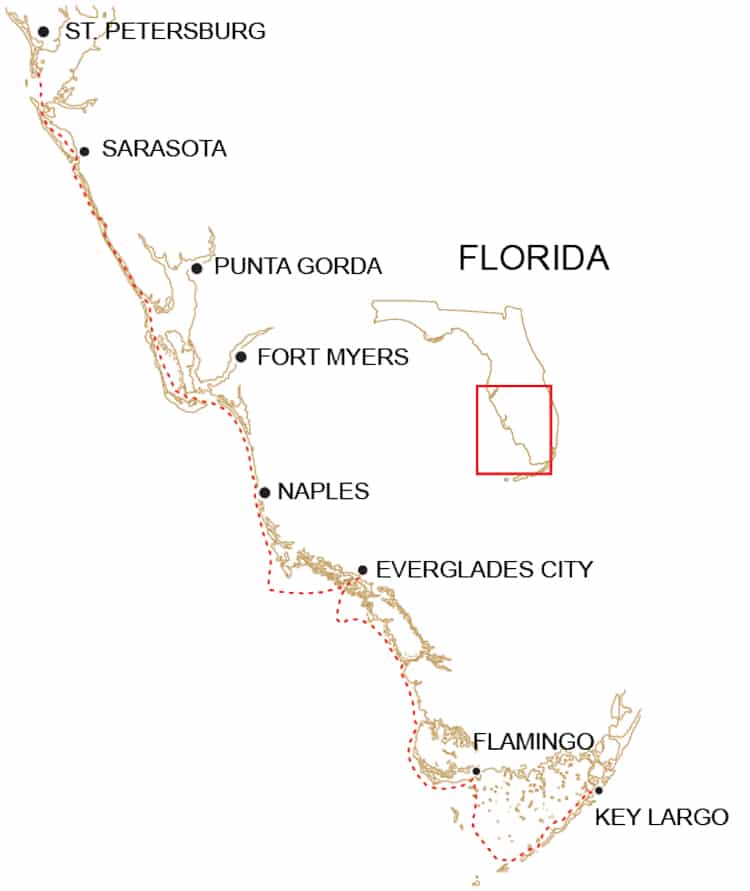
The following morning, I leave early to sprint to the Keys. I choose a route that takes me south and then east toward Key Largo. There is a more direct route, as the pelican flies, but with a forecast of increasing headwinds, I don’t like that alternative.
Once out of Flamingo’s channel, I employ a neat little trick I’ve learned Kairos can perform. With the daggerboard all the way up and my cassette rudder blade extending only as deep as the skeg of the main hull itself, I’m able to steer a controlled track downwind over mud flats as shallow as 10 inches. When the wind gets soft, I row a little.
The afternoon wind remains light, and I barely complete the crossing before dark, spending my final night on the course tied to a wrecked dock on Upper Matecumbe Key. There’s a bar on the other side of the noisy road, and at 4 a.m., police officers knock on my boat and ask that I move, citing liability reasons. I deploy my anchor 50 feet farther up this little creek and wait for sunrise.
A few hours later, a fresh southerly provides superb sailing conditions over flat water. A quick 25-mile dash and I’m crossing the finish on Key Largo by noon, relaxed, cruised and without a single blister. With one last competitor expected to arrive after me, the dropout rate will be less than 20 percent. At 5 p.m., the official post-race party starts at the local kayak outfitters shop, with beer, sushi and an impromptu memorial service for the deceased paddler.
While the Everglades Challenge is complete, for me at least, my mind and body crave the carefree rhythm of the previous days. I head out again the following morning, my bows pointing south to distant keys. The adventure continues.









